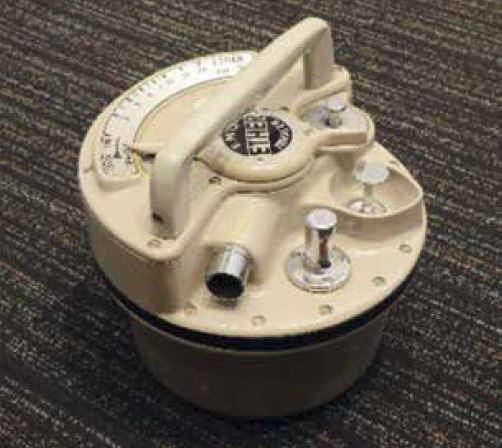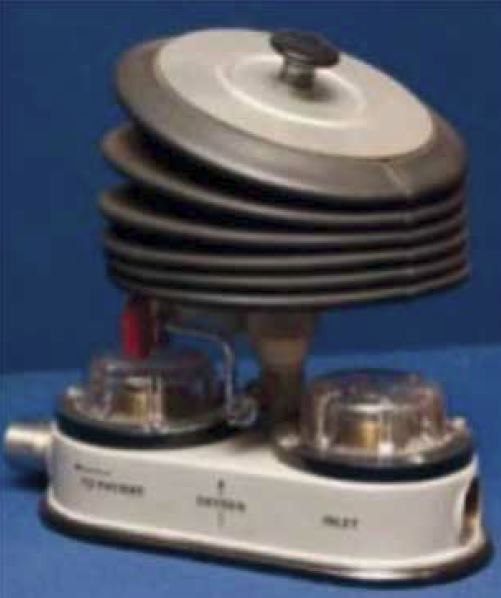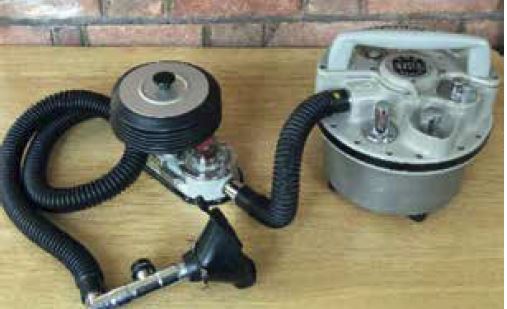© Hong Kong Academy of Medicine. CC BY-NC-ND 4.0
REMINISCENCE: ARTEFACTS FROM THE HONG KONG MUSEUM OF
MEDICAL SCIENCES
Epstein-Macintosh-Oxford Inhaler (EMO
anaesthetic apparatus)
Ronald Lo, FHKAM (Anaesthesiology), FANZCA
Guest author, Education and Research Committee, Hong Kong Museum of Medical Sciences Society
In a previous article in this section in 2014, I
discussed the use of the Schimmelbusch mask in
administering volatile anaesthetics, including ether.1
Another piece of anaesthetic apparatus in relation
to ether anaesthesia that can be found in the Hong
Kong Museum of Medical Sciences is the Epstein-Macintosh-Oxford inhaler (also known as the EMO
anaesthetic apparatus or simply as EMO) [Fig 1].
It was donated by Queen Mary Hospital to the
Museum in 1998.
Ether was a popular anaesthetic agent both
before and after the Second World War of 1939 to
1946. After ether was introduced to anaesthetic
practice in 1846, various pieces of apparatus were
designed for vaporising ether to be administered to
patients. One reason that this agent was popular was
its volatility, which allowed a wide range of clinical
concentrations to be achieved easily.
Early devices for the administration of volatile
anaesthetics, such as the Schimmelbusch mask,
were challenging to use and required experience
and skill of the anaesthetist. This was mainly due to
the difficulty in controlling the concentration of the
vapour being administered. In the case of ether, it
was exacerbated by the cooling of the liquid ether
on vaporisation, changing its volatility and hence the
concentration delivered to the patient.
Professor Sir Robert R Macintosh (1897-1989)
was born in New Zealand and fought in the First
World War. He completed his medical studies and
eventually became the founding professor of the
Nuffield Department of Anaesthesia at Oxford
University in the United Kingdom. Macintosh,
together with Dr HG Epstein, designed a drawover
anaesthetic vaporiser to deliver volatile anaesthesia,
the Oxford Vaporiser (1941).2 This was the first
generation of a variable bypass drawover (low
flow resistance) vaporiser for volatile anaesthetics
with reasonable control over the delivered vapour
concentration, using a crystalline jacket to utilise
the heat of crystallisation to keep the anaesthetic
warm during use. A redesigned miniature version
of the Oxford Vaporiser was subsequently used by
the military and others for field anaesthesia. It saw
service during the Second World War.
Macintosh and Epstein recruited scientist Dr
Kurt Mendelssohn and were assisted by Dr Richard
Salt to refine the Oxford Vaporiser in 1952. The
new apparatus (vaporiser) was first produced in
1953 by Pentland Scientific Co and named with its
designers’ initials (Epstein & Macintosh) and Oxford
where it was designed.3 The EMO was introduced in
19564 as a refined version of the Oxford Vaporiser,
designed to address the problem of variability of the
delivered concentration of ether that relates to the
change in its temperature during use. It retained the
drawover design of the Oxford Vaporiser but has a
more sophisticated temperature-sensitive bellows
mechanism which works as a “thermostat” to deliver
a constant pre-set concentration of ether during
clinical use despite ether temperature changes during
use. This capability is enhanced by the provision of
a water jacket around the anaesthetic reservoir as a
heat sink to maintain the temperature of the ether.
Hot or cold water (or even ice) could be added to
this jacket to allow the apparatus to be used within
its operational temperature range despite adverse
ambient temperatures or prolonged use. These
design features together with its relative portability
make it a very convenient all-in-one anaesthetic
apparatus that can be deployed not only in hospitals,
but also for providing anaesthesia in unsophisticated
environments and in environments where facilities
are limited. The EMO can also be used as an
add-on to other compatible anaesthetic systems.
It was extensively used all over the world since its
production and introduction. However, it should
be noted that the performance characteristic of the
EMO is not suitable for use in paediatric anaesthesia
where gas flows are lower than in the adult. Pentland
was renamed Penlon in 1962. The specimen held by
the Hong Kong Museum of Medical Sciences bears
the trademark of Penlon and thus would have been
produced after 1962.
The EMO is usually used together with
the Oxford Bellows (Fig 2) to provide artificial
ventilation during ether anaesthesia. It has a set of
two one-way valves to ensure that the gas flow goes
towards the patient when the bellows are operated
during artificial ventilation and prevents rebreathing
of expired gases. A magnet provided with the
Bellows allows one of the valves to be disengaged to
reduce flow resistance during spontaneous breathing
anaesthesia. The bellows in artificial ventilation
mode is operated by hand by the anaesthetist
or an assistant. Thus, the EMO/Oxford Bellows
combination (Fig 3) is not dependent on power
supply and has full operational flexibility in either
spontaneously breathing patients or artificially
ventilated patients. This made it very popular,
especially where available facilities were primitive
and ether could be easily obtained. A one-way valve
at the patient end of the breathing circuit, such
as the Ruben Valve or Ambu Valve,5 may be used
without the Oxford Bellows to enhance effectiveness
and efficiency in spontaneous breathing anaesthetic
techniques. In more recent times, a self-reinflating
resuscitator bag that can have the EMO connected
at its fresh gas inlet can be used for anaesthesia with
the EMO instead of the Oxford Bellows.6
The use of ether in hospital practice has declined
since the 1960s because of the introduction of newer
anaesthetic agents and anaesthetic techniques.
Nevertheless, the EMO did not disappear in less
developed countries until the 1970s or, in some
countries, well into the 1980s. Often, the EMO was
retained as a backup to modern anaesthetic facilities
in case of power failure or disasters. Hong Kong public
hospitals kept operational EMO units until they
were decommissioned in the early 1980s. Professor Macintosh, who was knighted in 1955, visited Hong
Kong in the mid-1970s and gave a lecture at the
invitation of the Society of Anaesthetists of Hong
Kong. The writer still remembers giving his last
ether anaesthetic with the EMO in 1982 at Princess
Margaret Hospital, Hong Kong, before the apparatus
was decommissioned.
References
1. Lo R. The Schimmelbusch mask. Hong Kong Med J 2014;20:560-1.
2. Epstein HG, Macintosh RR, Mendelssohn K. The Oxford Vaporiser No. 1. Lancet 1941;238:62-4. Crossref
3. EMO (Epstein, Macintosh, Oxford) ether inhaler & vaporiser. Geoffrey Kaye Museum of Anaesthetic History.
Available from: https://victoriancollections.net.au/items/552f18742162f10af8e24892. Accessed 17 May 2020.
4. Epstein HG, Macintosh R. An anaesthetic inhaler with automatic thermo-compensation. 1956. Anaesthesia
1956;11:83-8. Crossref
5. Ruben Non-Rebreathing Valve & Ambu E2 Valve. Available from: http://soa.group.shef.ac.uk/museum/ambu_ruben.
htm. Accessed 17 May 2020.
6. Fahey DG. The self-inflating resuscitator—evolution of an idea. Anaesth Intensive Care 2010;38 Suppl 1:10-5. Crossref




